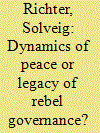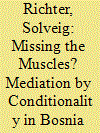| Srl | Item |
| 1 |
ID:
189354


|
|
|
|
|
| Summary/Abstract |
In the academic literature, it is widely accepted that one of the most difficult steps in a peace process is the reincorporation of former combatants. Colombia is a case in point. After the peace agreement with the former rebel group FARC-EP in 2016, the reintegration process of more than 13.000 ex-combatants has been marred with difficulties, be it half-hearted implementation of the stipulations of the accord from the side of the government or the re-armament of some dissident groups. However, the dynamics of the peace process differ considerably between the national and the local level, offering a wide range of pathways from even more violent confrontation up to successful reincorporation projects. In order to explain this variety, we integrate DDR and rebel governance studies and assume that socio-political orders need to be re-configurated when rebel groups have established strong forms of rebel governance, as was the case with the FARC-EP. We argue that patterns of interaction between local conflict-affected communities and ex-combatants are the key explanatory variables for the dynamics of peace processes at local level. We differentiate between clustered and entrenched post-war orders and demonstrate our argument with two case studies based on comprehensive field research.
|
|
|
|
|
|
|
|
|
|
|
|
|
|
|
|
| 2 |
ID:
159779


|
|
|
|
|
| Summary/Abstract |
In October 2009, the European Union, in conjunction with the United States, launched a high-level mediation effort in Butmir, Bosnia and Herzegovina, to reform the political structure of the state. Since 2005, the constitution which was included in the Dayton Peace Accord has been widely perceived as dysfunctional. In two negotiation rounds, the EU and the US put a comprehensive proposal on the table and showed strong leverage. However, the talks ended without a tangible result. To explain this failure, a theoretical model is developed based on both mediation and Europeanization literature to explore mediation by conditionality as a type of ‘directive mediation’ in a systematic way. Contrary to the argument that the EU lacked muscle, it is argued that pre-conditions for political conditionality were not fulfilled and strong leverage proved ineffective and counterproductive. These results question conditionality as an effective mediation strategy when state-building is contested between local parties.
|
|
|
|
|
|
|
|
|
|
|
|
|
|
|
|